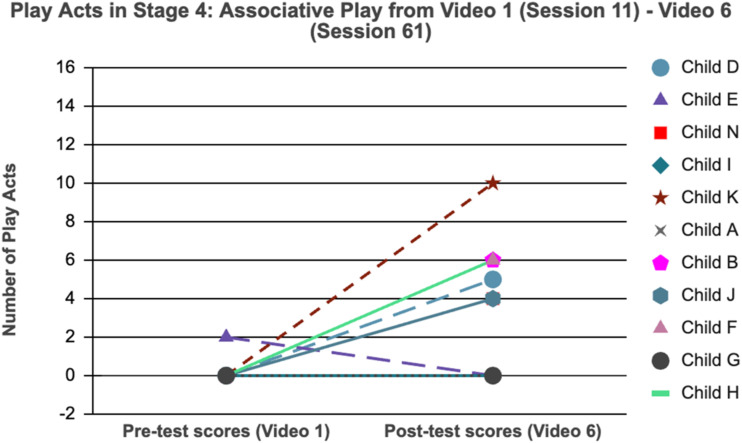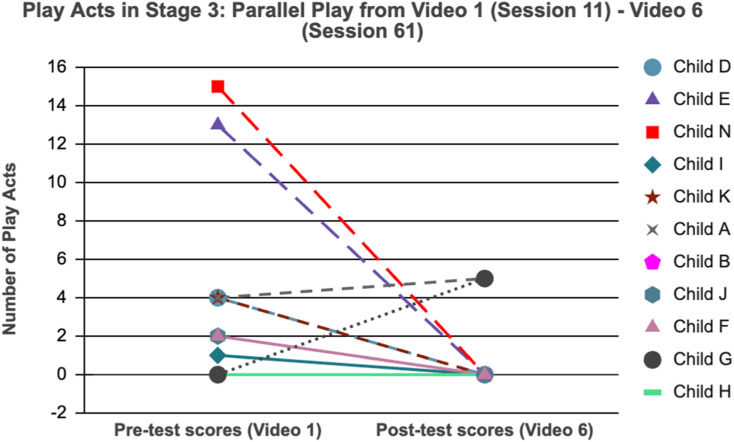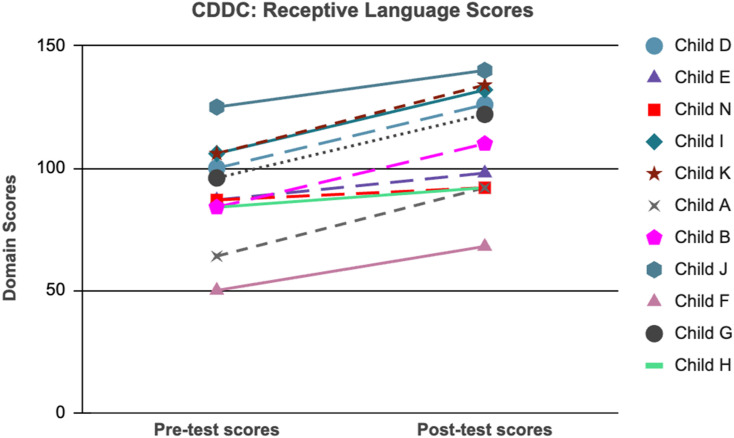Sara Ann Schuchert, Shivangi Khattar, Purva Tekkar, Aastha Rathour, Savita Dawar, Parul Gupta
下载PDF
{"title":"Exploring social stages of play through eye to I© intervention model.","authors":"Sara Ann Schuchert, Shivangi Khattar, Purva Tekkar, Aastha Rathour, Savita Dawar, Parul Gupta","doi":"10.1177/13591045231177477","DOIUrl":null,"url":null,"abstract":"<p><p>The study explores the role of the Eye to I© intervention model in facilitating advancement through social stages of play in which skills contribute to the quality of social interaction and communication in children with autism. Data were collected on 11 participants, ages of 2-6 years, formally diagnosed with autism, receiving Eye to I© Social Communication therapy at Potentials Therapy Center, New Delhi, India. Eye to I© is developed in-house at Potentials and is further discussed in the paper. All participants attended a form of group intervention. A mixed-method design included quantitative measures administered pre and post intervention (Communication DEALL Developmental Checklist, Communication Matrix) and video coding of Social Communication sessions. Qualitative measures were semi-structured parent interviews conducted at the end of intervention. Thematic analysis and quantitative statistical analysis results show that by the end of the Eye to I© intervention period children engaged in social stages of play of greater developmental complexity and showed increased scores in assessments of social skills as well as generalization of skills. This suggests that skill acquisition necessary to directly support two diagnostic criteria areas of autism as per DSM-V; i.e., communication and social interaction occurred during the period of intervention.</p>","PeriodicalId":48840,"journal":{"name":"Clinical Child Psychology and Psychiatry","volume":" ","pages":"928-948"},"PeriodicalIF":2.0000,"publicationDate":"2024-07-01","publicationTypes":"Journal Article","fieldsOfStudy":null,"isOpenAccess":false,"openAccessPdf":"https://www.ncbi.nlm.nih.gov/pmc/articles/PMC11188555/pdf/","citationCount":"0","resultStr":null,"platform":"Semanticscholar","paperid":null,"PeriodicalName":"Clinical Child Psychology and Psychiatry","FirstCategoryId":"3","ListUrlMain":"https://doi.org/10.1177/13591045231177477","RegionNum":4,"RegionCategory":"医学","ArticlePicture":[],"TitleCN":null,"AbstractTextCN":null,"PMCID":null,"EPubDate":"2023/5/26 0:00:00","PubModel":"Epub","JCR":"Q3","JCRName":"PSYCHIATRY","Score":null,"Total":0}
引用次数: 0
引用
批量引用
Abstract
The study explores the role of the Eye to I© intervention model in facilitating advancement through social stages of play in which skills contribute to the quality of social interaction and communication in children with autism. Data were collected on 11 participants, ages of 2-6 years, formally diagnosed with autism, receiving Eye to I© Social Communication therapy at Potentials Therapy Center, New Delhi, India. Eye to I© is developed in-house at Potentials and is further discussed in the paper. All participants attended a form of group intervention. A mixed-method design included quantitative measures administered pre and post intervention (Communication DEALL Developmental Checklist, Communication Matrix) and video coding of Social Communication sessions. Qualitative measures were semi-structured parent interviews conducted at the end of intervention. Thematic analysis and quantitative statistical analysis results show that by the end of the Eye to I© intervention period children engaged in social stages of play of greater developmental complexity and showed increased scores in assessments of social skills as well as generalization of skills. This suggests that skill acquisition necessary to directly support two diagnostic criteria areas of autism as per DSM-V; i.e., communication and social interaction occurred during the period of intervention.
通过 eye to I© 干预模式探索游戏的社会阶段。
本研究探讨了 "Eye to I©"干预模式在促进自闭症儿童社交互动和沟通质量的社会游戏阶段中的作用。研究收集了 11 名被正式诊断为自闭症的 2-6 岁参与者的数据,他们在印度新德里的 Potentials 治疗中心接受了 Eye to I© 社交沟通疗法。Eye to I© 是 Potentials 公司内部开发的,本文将对此作进一步讨论。所有参与者都参加了某种形式的小组干预。混合方法设计包括干预前后的定量测量(沟通 DEALL 发展核对表、沟通矩阵)和社会沟通课程的视频编码。定性测量是在干预结束时对家长进行的半结构化访谈。主题分析和定量统计分析结果表明,在 Eye to I© 干预期结束时,儿童参与的社交阶段游戏的发展复杂程度更高,社交技能评估得分和技能普及程度也有所提高。这表明,根据 DSM-V,自闭症的两个诊断标准领域(即沟通和社会交往)所需的技能学习在干预期间得到了直接支持。
本文章由计算机程序翻译,如有差异,请以英文原文为准。




 求助内容:
求助内容: 应助结果提醒方式:
应助结果提醒方式:


